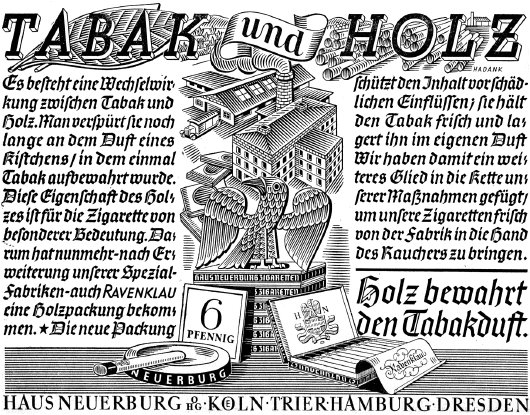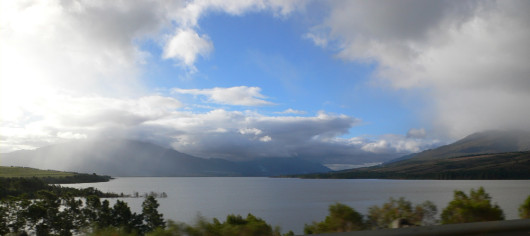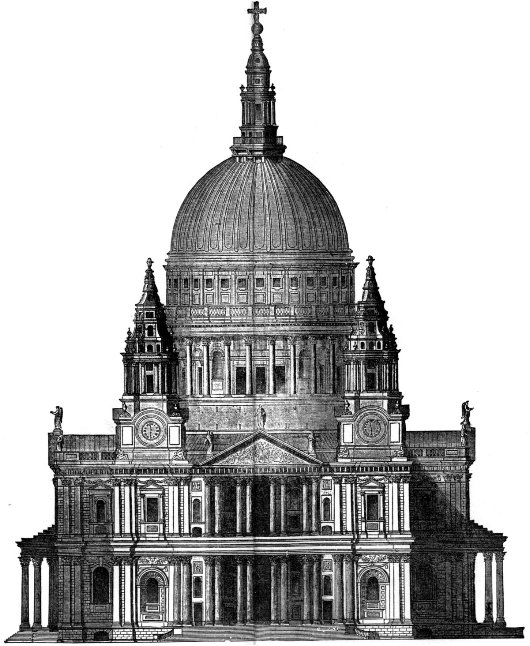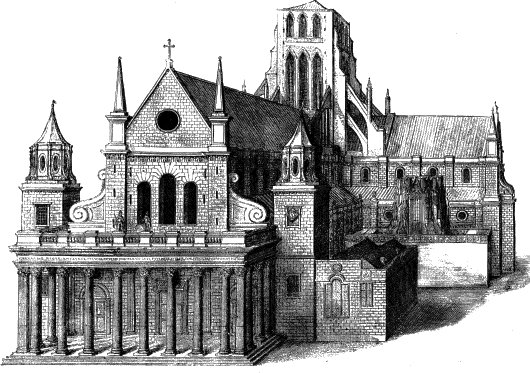World
About Andrew Cusack
 Writer, web designer, etc.; born in New York; educated in Argentina, Scotland, and South Africa; now based in London.
Writer, web designer, etc.; born in New York; educated in Argentina, Scotland, and South Africa; now based in London. read more
News
Blogs
Reviews & Periodicals
Arts & Design
World
France
Mitteleuropa
Knickerbockers
Argentina
The Levant
Africa
Cape of Good Hope
Netherlands
Scandinavia
Québec
India
Muscovy
Germany
Academica
…en dit is ’n foto van my in Suid-Afrika
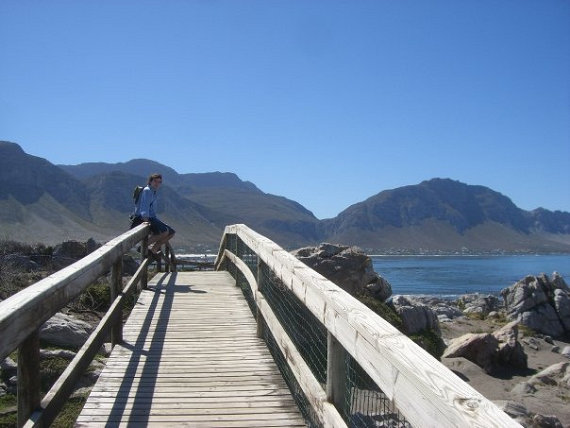
A reader has pointed out that, in all my posts on South Africa, those who frequent this little corner of the web have not seen so much as a single shot of your humble & obedient scribe in that southerly land. Such lack of photographic evidence, our correspondent argues, could provoke a wealth of conspiracy theories locating me, alternatively, within the deep recesses of the Vatican, training a small fighting force in the Salzkammergut, or, somewhat implausibly, in the Democratic People’s Republic of Korea.
(In truth, I have very, very few pictures of myself, as I am usually the one taking the pictures — some of which are electronically submitted for your approval here.)
And so, dear readers, you will find above a photograph of yours truly on one of my trips to Betty’s Bay, that splendid corner of the Cape.
Kiest Welter
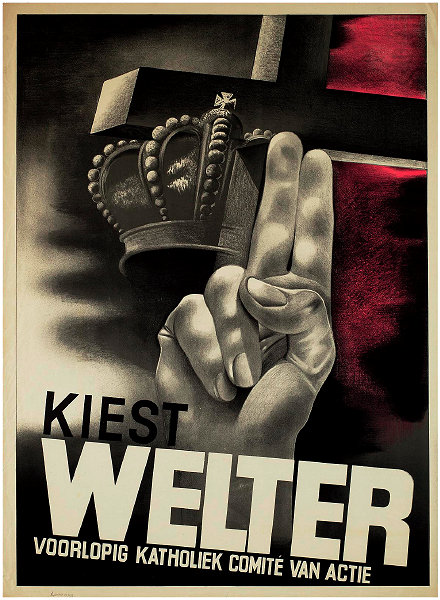
Christianity — Monarchy — Loyalty. This Dutch election poster urges voters to “Choose Welter”, referring to the sometime Dutch government minister Charles Welter. (more…)
Praga Caput Regni
Prague: Capital & Head of the Bohemian Realm

Prague is traditionally known as “Praga Caput Regni” — the capital of the realm, or indeed the head of the Bohemian body. Changing times and a different form of government mean that the arms of this ancient city now bear the motto “Praga Caput Rei Publicae” instead. The photographer Libor Sváček was born in the be-castled city of Krummau, and has a splendid book of photographs of that town, but here are a number of his photographs of Prague, which splendidly exhibit the Old Town at its most beautiful. (more…)
Gorham’s Pond Bridge
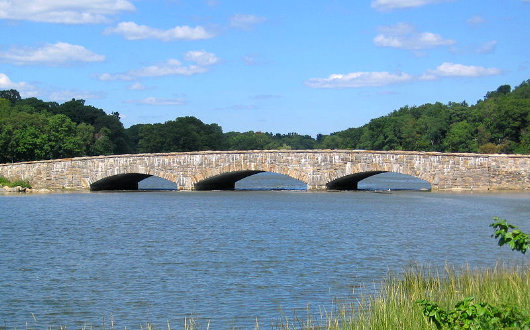
Gorham’s Pond Bridge spans the Goodwives River in Connecticut. Captain George Gorham was born in January 1696 (O.S.) at Barnstable in the Province of Massachusetts Bay. The Captain married Hannah Banks, a Greenwich girl, in 1726 and bought the grist mill in 1740. While most of this neck of the woods leaned towards the Rebels during the Revolution, Robert Gorham was a staunch Tory. From time to time, fellow Tories would land at Gorham’s Mill to raid local Rebel strongholds. After disturbing a meeting at the Congregational Meeting House — a local den of rebellion — the Rebels hid behind a stone wall waiting to ambush the Tories at an expected raid. The Tories, however, got wind of the plotted ambush, and snuck up behind the Rebels, launched a surprise attack, and duly won the skirmish.
Unusually, the revolutionary authorities allowed the Gorhams to remain in Connecticut, and their property was not confiscated. The family owned the Mill until it was destroyed by fire in the first half of the twentieth century. Gorham’s Landing is now within the town of Darien, and nearby is the Convent of St. Birgitta at Vikingsborg.

Quiringh Gerritsz. van Brekelenkam, Family Group at Dinner Table
Oil on canvas, 22 5/8 x 28 3/8 in.
1658-1660, J. Paul Getty Trust
Note: Previously attributed to Cornelis de Man.
A Tale of Two Headscarves
In Deference to Islam, U.S. Secretary of State Dons Headscarf, while that of Canadian Governor-General Michaëlle Jean is Conspicuous in its Absence
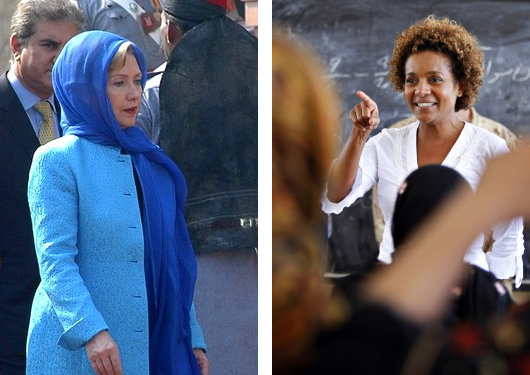
In the clash of civilisations between Islam and “the West”, there are Churchills and there are Chamberlains. A recent New York Times front-page photo shows U.S. Secretary of State Hillary Clinton donning a headscarf on her recent visit to Pakistan. But Michaëlle Jean, Canada’s Governor-General (and thus that country’s highest-ranking official after the Queen), recent journeyed to the “Af-Pak” region herself. Photos released by Rideau Hall show Her Excellency breezily taking questions from girls in an Afghan school build with Canadian development funds. The photos show a woman who appears free, confident, and easily engaged by her interactions with those around her. The contrast with Secretary Clinton couldn’t be greater.
The advice si fueris Romae, Romano vivito more, traditionally attributed to no less a sage than St. Ambrose, is sound counsel indeed, but one can’t help but wonder if in this circumstance the Governor-General’s way is the more appropriate one. How rare it is that we find Western leaders with enough self-assurance not to pander deferentially towards a culture alien to our own. Secretary of State Clinton, in her headscarf, broadcasts the signal that she is following an agenda set by others, whereas Governor-General Jean chooses to set the agenda herself — fitting for the viceroy of one of the most stable countries in the world, that enjoys an enviable constitutional longevity.

Still, the Governor-General’s head did not remain bare for the entirety of her visit to Afghanistan. Her Excellency is Colonel-of-the-Regiment of the three units of Canada’s household guard, and, donning the military beret, Madame Jean visited a memorial to the soldiers of her country who have given their lives in the endless conflict in Afghanistan. After the proper solemnities were observed, the Governor-General took a few moments to meet with some of the Canadian soldiers who stood guard during the ceremony.

Wits Scientists Unearth Afrikaans Dinosaur in the Orange Free State
Bones of “Aardonyx Celestae” on Display at the Transvaal Museum
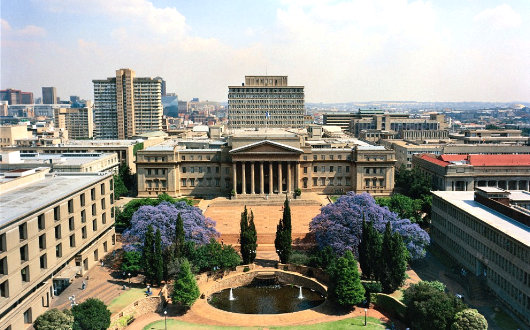
A NEW SPECIES OF dinosaur has been discovered in South Africa by a team of researchers from the University of Witwatersrand (above, colloquially known as “Wits”), and has been given an appropriately Afrikaans moniker. The new classification of Aardonyx Celestae is a combination of Afrikaans, Greek, and Latin meaning “Celeste’s Earth-claw”, after the female team member who first handled the speciment. The 23-foot long collection of fossils was found near Bethlehem in the Orange Free State, and, after the announcement before the gentlemen of the press, the bones are now displayed at the Transvaal Museum in the South African capital of Pretoria.
The specimen discovered is about 195 million years old, dating from the Early Jurassic Period (presuming one actually doubts Ussher’s chronology). Limb proportions lead the experts to believe that Aardonyx was a biped, although its forearm bones interlock (like those of quadrupeds) suggesting that it could occasionally walk on all-fours.
Unlike most Afrikaners, though, Aardonyx was a vegetarian, taking in huge mouthfuls of vegetation through its broad jaw.
Swinging round the Cape Peninsula
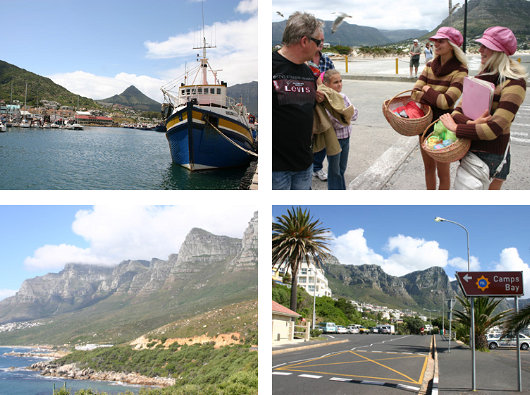
Visual editor and blogger Charles Apple gives us a photographic depiction of his Saturday touring the Atlantic side of the Cape Peninsula, from the V&A Waterfront, to Green Point, Three Anchor Bay, Sea Point, Clifton, Maiden’s Cove, Camps Bay, Bakoven, the Twelve Apostles, Llandudno, Hout Bay, and Chapman’s Peak. The photos are good, but still don’t do justice to that beautiful part of the world. They do, however, get me pining for the Peninsula!
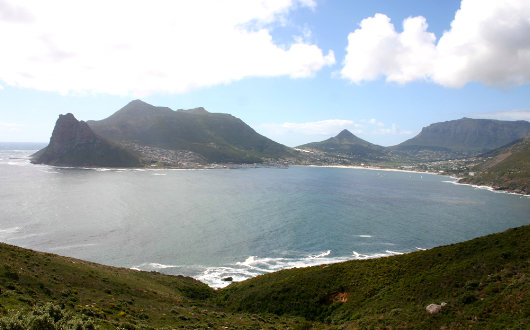
The Senate of South Africa
Die Senaat van Suid-Afrika
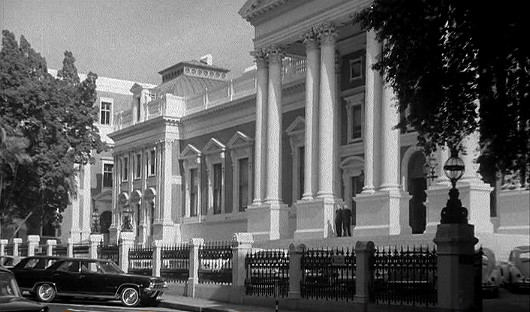
THE SENATE OF South Africa has had something of a tempestuous history, a fact which is attested to by the vicissitudes of the Senate chamber in the House of Parliament in Cape Town. The Senate formed the upper house of South Africa’s parliament from the unification of the country in 1910, in accordance with the proposals agreed to by Briton & Boer at the National Convention of 1908. Its members were originally selected by an electoral college consisting of the Provincial Councils of the Cape, the Transvaal, the Orange Free State, and Natal, and the members of the House of Assembly (the parliament’s lower house), along with a certain number of appointments by the Governor-General on the advice of the Prime Minister. When South Africa abolished its monarchy, the State President took over the appointing role held until then by the Governor-General, but the Senate remained largely intact until 1981, when it was abolished in advance of the foolish introduction of the 1984 constitution with its racial tricameralism.
The Senate made a brief comeback in 1994, when the interim constitution provided for a Senate composed of ninety members, ten elected by each of the provincial legislatures of the new provinces. The 1994 Senate, however, was replaced by the “National Council of Provinces” in the final 1997 constitution. (more…)
How “New Yorker” is the Staats-Zeitung?

When I was a youngin’, one of the joys of Sundays was the trip to the bakery and the newsagent after church. A vast array of newspapers was on hand for perusal while Pop nipped into Topps Bakery next door. We usually only bought The European, but I browsed everything on hand. One of the available titles was the New-Yorker Staats-Zeitung, founded in 1834, and the oldest German newspaper in the New World. The “Staats” was daily from 1854 until 1953, when it went weekly. In the late 1930s, the circulation was about 80,000, falling to 25,000 in the late 1990s, and stands around 10,000 today. It seems a pity that this “New York” newspaper is now edited from Sarasota, Florida instead of from Manhattan, but at least the Staats-Zeitung survives.
Udo & Marianna
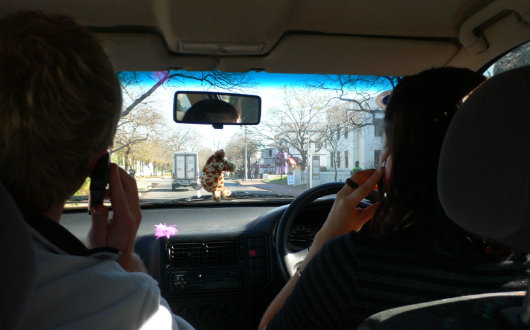
One’s chatting on the phone in Afrikaans, the other in Finnish.
The Houses of Parliament, Cape Town
Die Parlementsgebou, Kaapstad.
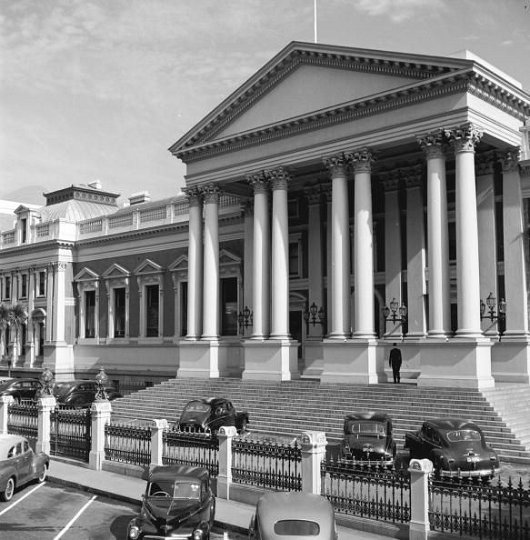
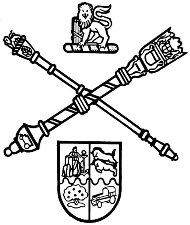
The insignia of the Parliament of South Africa, showing the Mace and Black Rod crossed between the shield and crest of the traditional arms of South Africa.
CAPE TOWN IS justifiably known as the “mother-city” of all South Africa, paying tribute to that day over three-hundred-and-fifty years ago when Jan van Riebeeck planted the tricolour of the Netherlands on the sands of the Cape of Good Hope. Numerous political transformations have taken place since that time, from the shifting tides of colonial overlords, to the united dominion of 1910, universal suffrage in 1994, and beyond. The history of self-government in South Africa has unfolded in a well-tempered, slow evolution rather than the sudden revolutions and tumults so frequent in other domains. No building has born greater witness to this long evolution than the Parliament House in Cape Town.
The British first created a legislative council for the Cape in 1835, but it was the agitation over a London proposal to transform the colony into a convict station (like Australia) that threw European Cape Town into an uproar. The proposal was defeated, but the colonists grew concerned that perhaps they were better guardians of their own affairs than the Colonial Office in far-off London. In 1853, Queen Victoria granted a parliament and constitution for the Cape of Good Hope, and the responsible government the Kaaplanders so desired was achieved. (more…)
Our Cardinal & Our Seminarians
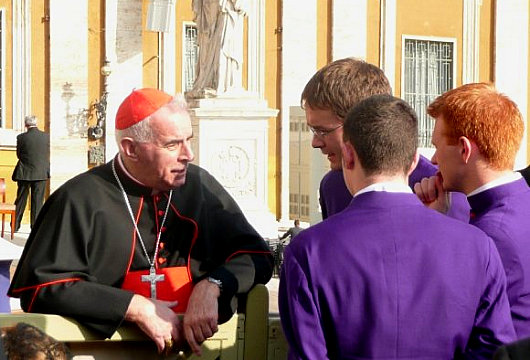
His Eminence Keith Patrick O’Brien, Cardinal Archbishop of St Andrews & Edinburgh, Primate of Scotland, has a wee chat with a triumvirate of seminarians from the Pontifical Scots College, Rome at the Holy Father’s weekly general audience. St Andreans (or at least Old Canmoreans) will recognize the ginger chap at right, attentively listening to the Cardinal’s words. I caught up with him in August when he had just a week to go before heading to seminary.
The Would-Be King of New Zealand
Brigadier the Right Honourable Sir Bernard Fergusson,
Baron Ballantrae, KT, GCMG, GCVO, DSO, OBE
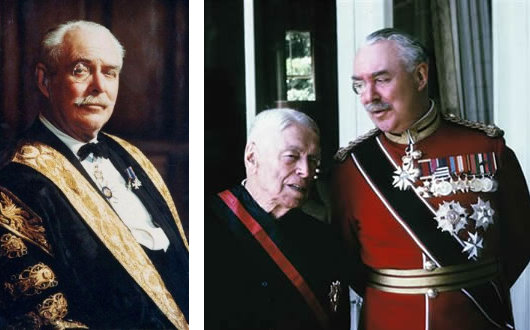
Left, Lord Ballantrae in his robes of office as Chancellor of the University of St Andrews; Right, as Governor-General of New Zealand with former Prime Minister Sir Walter Nash.
Over at Curated Secrets, Stephen Klimczuk takes a brief wander through Clubland, mentioning the illustrious Bernard Fergusson, who was known for “the skill with which he could toss his monocle in the air and catch it in his eye”. Stephen’s co-author on Secret Places, Hidden Sanctuaries, the Much Hon. Laird of Craiggenmaddie, chimes in on the commentbox, bringing to light that “when he was serving under Orde Wingate with the Chindits in Burma, among the supplies dropped by the RAF to those doughty warriors was a supply of monocles for Fergusson, since the damage/loss rate was so high in the jungle.”
Fergusson has always fascinated me, not only because he was the Chancellor of my university, but also because he has the best claim to the throne of New Zealand should the Land of the Long White Cloud ever decide to dispense with the House of Windsor. Lord Ballantrae (as Fergusson was ennobled) served as Governor-General of New Zealand, his own father served as Governor-General of New Zealand, and both his grandfathers served as Governor of New Zealand before the antipodean kingdom became a dominion. Rather appropriately, his son and heir is currently serving as Her Majesty’s High Commissioner to New Zealand, which is now the highest office of the British government in those islands.
Stephen mentions other fun stories of Clubland, such as the waggish response of the dinner guest who was kept waiting for Hermann Goering at one club before the war: “‘I have been shooting,’ said Goering. ‘Animals, I hope?’ was the quite reasonable question in response.”
A Message from the Minister of Culture
I’ve sometimes thought that the Director of the Metropolitan Museum is New York’s unofficial Minister of Culture. Concerned New Yorkers were at the edge of their seats with anticipation to discover who would be chosen to direct this great museum once it was announced that the legendary Philippe de Montebello was relinquishing the throne. As The New Criterion put it “Few events have been awaited with more trepidation in the world of culture — we were going to say ‘the art world,’ but it embraces much more than that — than the appointment of the next director of the Metropolitan Museum of Art.”
The massive sigh of relief when Thomas Campbell was announced as the successor could probably be heard as far as the Louvre (or even the Hermitage), even though Campbell’s name was on none of the supposed shortlists for the job. Judging by his past as curator of tapestries, Campbell is widely believed to be utterly reliable at continuing the high standard maintained during de Montebello’s reign. May God guide him well in his task! (more…)
Argentines Recall Blessed Emperor

An Argentine correspondent informs us that the Holy Sacrifice of the Mass was offered on October 28th at the Church of St. Boniface, the German-speaking parish of the Archdiocese of Buenos Aires, to commemorate the fifth anniversary of the beatification of Blessed Charles, Emperor of Austria and Apostolic King of Hungary. The mass was organized by Viscountess Huges Stier de Saint Jean (née Princess Isabelle Auersperg-Breunner), whose mother was a descendant of the Emperor Franz Joseph through his daughter Valerie. The Mass was offered in Spanish and German, with the prayers of intention read in those languages as well as Hungarian, Slovak, Ukrainian, Croatian, and Italian.
Category: Charles of Austria
Search
Instagram: @andcusack
Click here for my Instagram photos.Most Recent Posts
- Amsterdam November 26, 2024
- Silver Jubilee November 21, 2024
- Articles of Note: 11 November 2024 November 11, 2024
- Why do you read? November 5, 2024
- India November 4, 2024
Most Recent Comments
- on The Catholic Apostolic Church, Edinburgh
- on Articles of Note: 11 November 2024
- on Articles of Note: 11 November 2024
- on Why do you read?
- on Why do you read?
- on University Nicknames in South Africa
- on The Situation at St Andrews
- on An Aldermanian Skyscraper
- on Equality
- on Rough Notes of Kinderhook
Book Wishlist
Monthly Archives
Categories

